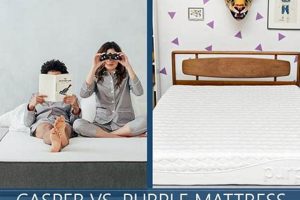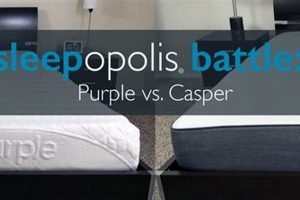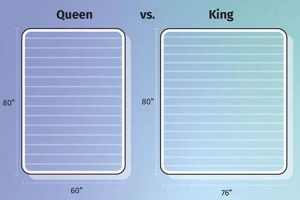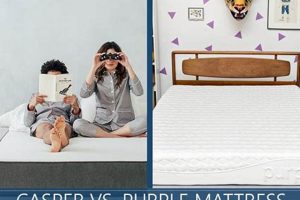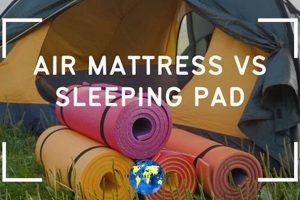The dimensions of recreational vehicle (RV) mattresses often differ significantly from those of standard residential mattresses. These variances arise primarily from the space constraints inherent in RV design, prioritizing functionality and mobility over the spaciousness typical of bedrooms in stationary homes. For example, an RV queen mattress may be shorter than a traditional queen to accommodate wheel wells or storage compartments.
Understanding these dimensional distinctions is crucial for RV owners seeking comfortable and appropriate bedding. Selecting a correctly sized mattress ensures optimal use of limited space, prevents damage to the RV interior, and contributes to a more restful travel experience. Historically, RV mattresses were often afterthoughts in vehicle design, but increasing demand for comfort and customization has led to greater availability of specialized RV mattress options.
This discussion will delve into the specific dimensional variations between RV and residential mattresses, explore common RV mattress types, and provide guidance on selecting the most suitable mattress for individual needs and RV specifications, ultimately enhancing the comfort and livability of the mobile living space.
RV Mattress Dimensions Compared to Standard Sizes
Selecting the appropriate mattress requires careful consideration of space and comfort. The following tips address key differences and offer guidance in making informed decisions.
Tip 1: Measure Available Space Accurately: Prior to purchasing any mattress, precise measurements of the RV’s designated sleeping area are paramount. Account for any obstructions, such as wheel wells or built-in furniture, that may impact mattress dimensions.
Tip 2: Understand Standard RV Mattress Sizes: Familiarize yourself with common RV mattress sizes, including short queen, RV full, and bunk options. These dimensions often differ from traditional mattress sizes and must align with available space.
Tip 3: Consider Mattress Thickness: RVs often have limited headroom. A thicker mattress may reduce usable space and comfort. Evaluate the optimal thickness based on individual needs and RV ceiling height.
Tip 4: Evaluate Mattress Material and Support: The materials used in construction impact both comfort and weight. Lighter mattresses are advantageous in RVs to minimize overall vehicle weight. Memory foam, latex, and innerspring options each offer unique characteristics.
Tip 5: Prioritize Comfort for Travel: Extended periods spent on the road necessitate a mattress that provides adequate support and pressure relief. Consider personal sleep preferences and potential back or joint issues when selecting a mattress.
Tip 6: Research Custom Mattress Options: If standard RV mattress sizes do not adequately fit the available space, explore custom-made mattress solutions. These allow for precise tailoring to specific dimensions and comfort requirements.
Tip 7: Factor in Ease of Movement and Storage: When not in use, some RV mattresses may need to be stored or manipulated. Lighter and more flexible mattresses are easier to handle in confined spaces.
Adhering to these tips ensures that the selected mattress optimizes space utilization, comfort, and overall functionality within the RV environment.
The next section will explore specific mattress types commonly used in recreational vehicles, examining their pros and cons in relation to weight, comfort, and durability.
1. Length variations
Length variations are a primary point of differentiation between recreational vehicle (RV) and standard residential mattresses. The confined spaces typical of RVs often necessitate shorter mattress lengths to accommodate interior layouts, thereby diverging from standardized mattress dimensions found in homes.
- Short Queen Dimensions
The short queen, a common RV mattress size, exemplifies length variations. While a standard queen mattress measures 80 inches in length, a short queen typically measures around 75 inches. This seemingly minor reduction significantly impacts RV interior design, allowing for improved maneuverability within the limited space of a camper or motorhome. The reduction in length comes with a tradeoff in sleeping space, potentially impacting comfort for taller individuals.
- Bunk Mattress Length Limitations
RV bunk mattresses, frequently used in family-oriented RVs, present further length limitations. These mattresses often must fit within a pre-defined bunk structure, resulting in lengths significantly shorter than a standard twin mattress. The dimensions of bunk mattresses are often tailored to the specific RV model, requiring careful measurement before purchasing replacement bedding. These lengths may compromise comfort for adult users or older children.
- Custom Mattress Solutions
Addressing the challenges posed by length variations, custom mattress options provide tailored solutions for RV owners. These custom mattresses can be manufactured to match the exact dimensions of the available space, ensuring a precise fit. Custom solutions often come at a higher price point, but they offer the benefit of optimizing both comfort and space utilization within the RV.
In summary, length variations in RV mattresses are a direct response to the constraints of mobile living. The differences from standard dimensions impact comfort and usability, making precise measurement and awareness of available options critical for RV owners. These variations underscore the need for careful consideration when selecting a mattress for a recreational vehicle, balancing space efficiency with individual sleeping preferences.
2. Width differences
Width differences between RV and regular mattresses are a critical aspect of discerning suitability within the confined spaces of recreational vehicles. Standard residential mattresses adhere to established width dimensions. Conversely, RV mattress widths are often modified to maximize limited floor space and accommodate structural components. The effect of failing to account for these disparities can result in a mattress that obstructs walkways, impedes access to storage, or simply cannot fit within the designated sleeping area. This consideration is paramount when comparing overall mattress sizes.
For instance, a standard full-size mattress typically measures 54 inches wide. An RV full-size mattress, however, may be narrower to allow for easier passage around the bed. Similar discrepancies exist among queen-size and king-size mattresses, where RV variants prioritize space efficiency. Ignoring width differences could lead to purchasing a mattress that necessitates costly alterations to the RV interior or, at worst, an unusable sleeping arrangement. Proper measurement and a clear understanding of available space are thus essential before committing to a purchase.
In conclusion, awareness of width variations between RV and standard mattresses is crucial for optimizing space and ensuring a comfortable sleeping environment within a recreational vehicle. Addressing this factor enables RV owners to make informed decisions, avoiding potential compatibility issues and maximizing the functionality of their mobile living space. These width variations emphasize the necessity of detailed measurements and careful consideration of RV-specific mattress options.
3. Thickness constraints
Thickness constraints represent a significant factor in the differentiation between RV mattress sizes and standard residential mattress sizes. The limited vertical space within recreational vehicles often necessitates thinner mattresses than those typically found in homes. This constraint impacts comfort, support, and overall suitability for RV use. The height of the mattress must accommodate overhead cabinets, low ceilings, and slide-out mechanisms, aspects not typically relevant in residential settings.
A thicker standard mattress might provide superior comfort and support, but within an RV, it could obstruct access to overhead storage or create an uncomfortable sleeping environment due to reduced headroom. Conversely, an overly thin mattress, chosen solely for its low profile, might compromise sleep quality. A practical example is an RV with a bunk bed setup; a thick mattress on the upper bunk could leave insufficient space for occupants to sit up comfortably. Manufacturers address these challenges by producing mattresses with specialized constructions and materials designed to offer adequate support within a thinner profile.
The consideration of thickness constraints is, therefore, integral to selecting the appropriate mattress for an RV. It requires balancing the need for comfort and support with the physical limitations imposed by the vehicle’s design. Understanding this relationship is crucial for RV owners seeking to optimize their mobile living space and ensuring a restful travel experience. Overlooking this aspect can lead to discomfort, inconvenience, and the need for costly replacements.
4. Corner shaping
Corner shaping is a crucial element when considering RV mattress sizes versus regular mattress dimensions. The interiors of recreational vehicles often feature curved walls or non-rectangular spaces, necessitating mattresses with modified corners to fit appropriately. The standard rectangular shape of residential mattresses is often unsuitable for these configurations. Corner shaping, therefore, represents a significant adaptation made to RV mattresses to ensure optimal space utilization and functionality within the vehicle.
The absence of proper corner shaping can lead to several issues. A standard mattress placed in an RV with curved walls will leave unusable gaps, wasting valuable space and potentially creating safety hazards. For instance, a mattress without a rounded corner in an RV with a curved wall might impede access to a storage compartment or create a tripping point. The precise nature of corner shapingwhether rounded, angled, or notcheddepends on the specific RV model and its interior design. Custom mattress manufacturers often provide templates or require detailed measurements to ensure accurate corner shaping, demonstrating the practical significance of this feature.
In summary, corner shaping distinguishes RV mattresses from their residential counterparts by prioritizing form-fitting design within confined and often irregularly shaped spaces. This adaptation is essential for maximizing space utilization, ensuring safety, and maintaining the functionality of the RV interior. Recognizing the importance of corner shaping is a vital aspect of selecting the right mattress and optimizing the comfort and livability of a recreational vehicle.
5. Weight limitations
Weight limitations are a critical factor influencing the design and selection of RV mattresses when considered against standard residential mattresses. Recreational vehicles operate under strict weight restrictions to ensure safe handling, fuel efficiency, and compliance with legal regulations. The mass of the mattress directly contributes to the overall vehicle weight, impacting these crucial aspects. Consequently, RV mattresses are often engineered with lighter materials and reduced dimensions compared to their residential counterparts, prioritizing weight reduction over maximizing comfort features found in standard mattresses.
The effect of exceeding weight limitations can range from diminished fuel economy and increased wear and tear on vehicle components to compromised handling and potential safety hazards. For example, replacing a factory-installed RV mattress with a heavier residential model could inadvertently push the vehicle over its maximum allowable weight, leading to regulatory penalties or, more seriously, contributing to an accident. Therefore, the selection of an RV mattress must carefully consider the weight implications. Manufacturers provide detailed weight specifications, and RV owners should meticulously compare these figures against the vehicle’s load capacity. Material choices, such as lightweight foams or reduced-coil innerspring systems, are common strategies for mitigating weight.
In conclusion, weight limitations exert a defining influence on RV mattress sizes and material composition. Unlike residential settings, where weight is a secondary consideration, RVs necessitate a careful balance between comfort and weight management. Understanding and adhering to these limitations is paramount for ensuring safe and efficient operation of the recreational vehicle. This necessitates informed decision-making, prioritizing lighter materials and appropriate dimensions to maintain compliance and maximize the vehicle’s performance.
6. Material impact
The materials used in both recreational vehicle (RV) mattresses and standard residential mattresses significantly influence comfort, durability, weight, and overall suitability. Material selection represents a critical consideration when differentiating between these two categories of bedding, directly impacting user experience and logistical practicality.
- Weight Considerations of Core Materials
The core material of a mattress, whether foam, innerspring, or a hybrid construction, heavily influences its weight. RV mattresses often utilize lighter foams, such as low-density polyurethane, to minimize overall vehicle weight. This contrasts with residential mattresses, which may incorporate denser materials like memory foam or latex for enhanced comfort, without primary concern for weight. The differential emphasis on weight affects material choice and, consequently, the structural integrity and longevity of RV mattresses.
- Cover Fabric Durability and Breathability
The cover fabric’s durability and breathability are key factors. RV mattresses, exposed to varying climates and potential moisture, often employ synthetic fabrics designed for resilience and ease of cleaning. Standard mattresses, while also prioritizing durability, may emphasize natural fibers like cotton for enhanced breathability and comfort. The choice of fabric impacts the mattress’s ability to regulate temperature and resist wear, reflecting the differing environmental demands.
- Fire Retardancy Standards Compliance
Fire retardancy standards influence material selection. Both RV and residential mattresses must meet specific safety regulations. However, the methods of achieving fire retardancy can differ. RV mattresses might use inherently fire-resistant materials or chemical treatments that minimize off-gassing within the confined space of the vehicle. Residential mattresses have broader options, potentially incorporating natural fire barriers like wool. The need for non-toxic solutions is paramount in the limited RV environment.
- Impact on Comfort and Support
Material directly affects comfort and support. While both RV and standard mattresses aim to provide adequate spinal alignment, RV mattresses often compromise on material density to reduce weight or size. This can result in reduced support compared to a residential mattress of similar construction. The trade-off between comfort and practicality is a defining characteristic of RV mattress design, necessitating a balance between sleeping quality and vehicle functionality.
The varied material compositions of RV and residential mattresses reflect their distinct design priorities. RV mattresses emphasize weight reduction, durability, and safety within confined spaces, often accepting compromises in comfort compared to residential mattresses. Material selection, therefore, encapsulates a critical aspect of the RV mattress versus regular mattress comparison, underscoring the practical and logistical constraints unique to mobile living.
Frequently Asked Questions
The following section addresses common inquiries regarding the dimensional and structural differences between recreational vehicle (RV) mattresses and standard residential mattresses. The information provided aims to clarify key distinctions and assist in making informed purchasing decisions.
Question 1: Are standard residential mattress sizes directly interchangeable with RV mattress sizes?
No, standard residential mattress sizes are generally not directly interchangeable with RV mattress sizes. RV mattresses often feature non-standard dimensions, including shorter lengths, narrower widths, and reduced thicknesses, to accommodate the space constraints within recreational vehicles. Attempting to fit a standard mattress into an RV can result in significant space inefficiencies and potential damage to the vehicle’s interior.
Question 2: What are the most common RV mattress sizes encountered?
Common RV mattress sizes include short queen (approximately 60″ x 75″), RV full (approximately 53″ x 75″), and bunk mattress sizes which vary considerably but are generally smaller than a standard twin. These dimensions deviate from standard residential sizes to optimize space utilization within the limited confines of an RV.
Question 3: Why are RV mattresses often thinner than regular mattresses?
RV mattresses are frequently thinner to accommodate headroom limitations, slide-out mechanisms, and overhead storage compartments within the vehicle. Thicker mattresses may obstruct access or create discomfort due to reduced vertical space. This thickness constraint necessitates careful consideration of comfort and support when selecting an RV mattress.
Question 4: Does the weight of an RV mattress matter?
Yes, the weight of an RV mattress is a crucial consideration. Exceeding weight limitations can negatively impact fuel efficiency, vehicle handling, and overall safety. Lighter materials and reduced dimensions are often employed in RV mattress construction to minimize weight contribution to the vehicle’s total load.
Question 5: Are custom-sized mattresses a viable option for RVs?
Custom-sized mattresses offer a viable solution for RVs with unique or non-standard sleeping area dimensions. This option allows for precise tailoring to specific space constraints and comfort requirements, ensuring optimal fit and utilization of available space. However, custom mattresses typically incur a higher cost compared to standard sizes.
Question 6: How does material selection differ between RV mattresses and standard mattresses?
Material selection differs primarily due to weight and environmental considerations. RV mattresses often utilize lighter foams and durable, easy-to-clean fabrics to minimize weight and withstand varying climates. Standard mattresses may prioritize denser materials and natural fibers for enhanced comfort and breathability, without the same emphasis on weight reduction.
In summary, understanding the distinctions between RV and standard mattresses is essential for selecting appropriate bedding that maximizes space, comfort, and safety within the recreational vehicle environment. Careful consideration of dimensions, weight, and material is paramount.
The subsequent section will delve into specific types of RV mattresses and provide guidance on selecting the optimal choice based on individual needs and preferences.
RV Mattress Sizes vs Regular Mattress
The preceding analysis has established that RV mattress sizes differ substantially from regular mattress dimensions. These variations are not arbitrary but driven by the practical constraints of recreational vehicle design, including space limitations, weight restrictions, and the need to accommodate unique interior configurations. A clear understanding of these distinctions is paramount for RV owners seeking to optimize comfort and functionality within their mobile living spaces.
Given the specific challenges associated with RV bedding, prospective purchasers must prioritize accurate measurements, a thorough understanding of available RV mattress sizes, and a careful evaluation of material composition and weight. Failure to account for these factors can result in compromised comfort, inefficient space utilization, and potential safety concerns. Therefore, informed decision-making is crucial for ensuring a restful and secure travel experience.


